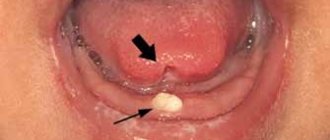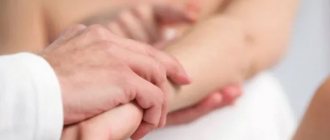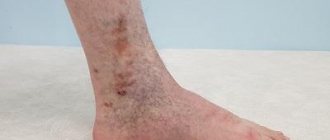Pemphigus
Pemphigus has a long, undulating course, and the lack of adequate treatment leads to disruption of the patient’s general condition. In the vulgar form
pemphigus blisters are localized throughout the body, have different sizes and are filled with serous contents, while the covering on the blisters is sluggish and thin.
Pemphigus vulgaris usually makes its debut on the mucous membranes of the mouth and nose, and therefore patients receive therapy from dentists and otolaryngologists for a long time and without success. At this stage of pemphigus, patients complain of pain during eating and talking, hypersalivation and a specific bad breath. The duration of this period is from three months to a year, after which pemphigus becomes widespread and the skin is involved in the inflammatory process.
Sometimes patients do not notice the presence of blisters because of their small size and thin covering; the blisters open quickly, and therefore the main complaints of patients with pemphigus at this period are painful erosions. Long-term and unsuccessful therapy for stomatitis is carried out before pemphigus is diagnosed. Blisters that are localized on the skin tend to spontaneously open, exposing the eroded surface and the remains of the tire, which shrinks into crusts.
Erosion in pemphigus is bright pink, with a smooth glossy surface; they differ from erosion in other diseases by their tendency to grow peripherally and to generalize with the formation of extensive lesions. If pemphigus takes this course, the patient’s general condition worsens, intoxication develops, a secondary infection develops, and without proper treatment, such patients die. With pemphigus vulgaris, Nikolsky syndrome is positive in the lesion and sometimes on healthy skin - with minor mechanical impact, detachment of the upper layer of the epithelium occurs.
Erythematous pemphigus
differs from vulgar in that at the beginning the skin is affected; erythematous lesions on the chest, neck, face and scalp are seborrheic in nature, have clear boundaries, the surface is covered with yellowish or brown crusts of varying thickness. If these crusts are separated, the eroded surface is exposed.
With erythematous pemphigus, the blisters can be small, their cover is flabby and sluggish, they spontaneously open very quickly, therefore it is extremely difficult to diagnose pemphigus. Nikolsky's symptom, as with erythematous pemphigus, can be localized for several years, then, as the process generalizes, it acquires vulgar features. Erythematous pemphigus should be differentiated from lupus erythematosus and seborrheic dermatitis.
Pemphigus foliaceus
clinically manifested by erythematous-squamous rashes, thin-walled blisters tend to appear on previously affected areas; after opening the blisters, a bright red eroded surface is exposed, upon drying of which lamellar crusts are formed. Since with this form of pemphigus blisters also appear on the crusts, the affected skin is sometimes covered with a massive layered crust due to the constant separation of exudate. Pemphigus leaf affects the skin, but in very rare cases, lesions of the mucous membranes are observed; it quickly spreads throughout healthy skin and at the same time there are blisters, crusts and erosions on the skin, which merge with each other to form an extensive wound surface. Nikolsky's symptom is positive even on healthy skin; with the addition of pathogenic microflora, sepsis develops, which usually causes the death of the patient.
Pemphigus vegetans
It is more benign, sometimes patients remain in satisfactory condition for many years. The blisters are localized around natural openings and in the area of skin folds. Opening up, the bubbles reveal erosions, at the bottom of which soft vegetations with a fetid odor are formed; the vegetations are covered on top with a serous or serous-purulent coating. There are pustules along the periphery of the formations, and therefore vegetative pemphigus must be differentiated from vegetative chronic pyoderma. Nikolsky syndrome is positive only near the affected skin, but in the terminal stages pemphigus vegetans is similar to pemphigus vulgaris in its clinical manifestations.
Symptoms of viral pemphigus in children
The disease in children most often manifests itself with the following symptoms:
- Formation of specific blisters on the epidermis that contain liquid;
- Cough;
- Redness of the throat;
- Formation of wounds and blisters on the mucous membranes;
- Runny nose;
- Weakness;
- Lack of appetite;
- The child becomes passive and constantly sleeps;
- Sharp weight loss;
- High body temperature.
Most often, the first affected areas in the form of blisters form on the mucous membranes of children. However, blisters may occur on the arms, legs, face, and body.
At a complex stage of development of viral pemphigus in children, blisters and serous fluid may appear on the palms of the hands.
Drug treatment of pemphigus in children
Treatment of this type of disease is most often carried out in several ways, depending on the cause of its occurrence.
There are several methods of treating viral pemphigus in children.
General therapy is necessary to eliminate the virus from the body and strengthen the immune system's resistance to other types of infections.
The most commonly prescribed drugs are:
- Antiviral agents - for example, Viferon rectal suppositories - are recommended to be used twice a day. The course of treatment is no more than 10 days. Allowed for use from 1 month of age. Average price 240 rubles ;
- Glucocorticosteroids are used individually for each child. The most commonly used is Dexamethasone, once a day before meals, for a course of no more than 3 days. Average price 150 rubles ;
- Cytostatics are necessary to block further spread of the disease. The most commonly prescribed drug is Sandimmune, used twice a day before meals for 5 days. Permitted age is over 6 years. Average cost 1300 rubles ;
- Antipyretics – Nurofen, used only if necessary depending on the child’s weight. Allowed to be used in the form of syrup from 3 months. Cost from 120 rubles .
Viferon
Dexamethasone
Sandimmune
Nurofen
Topical treatment is used to treat blisters, the most commonly used are:
- Antiseptics – Chlorhexidine, recommended for use on wounds twice a day for 5 days, allowed for use in children over 7 years of age. Average price 80 rubles , avoid contact of the drug with soap. An allergic reaction may occur. And also Miramistin, which can be used from a month of life, diluted with water in a 1:1 ratio. Cost from 240 rubles ;
- Combined antiseptic drugs - special talkers are used, which are made according to an individual prescription from the attending physician, depending on the complexity of the disease. On average, the cost of such talkers depends on the price of the components and can vary from 150 to 300 rubles :
- Antimicrobial drugs for the oral cavity - Orasept is used twice a day for 5 days. Can be used from the age of 3 years. The average price of the drug is 300 rubles . For children under 12 years of age, oral cavity treatment is performed by adults to prevent cases of overdose.
Chlorhexidine
Miramistin
Orasept
Physiotherapy – prescribed by the attending physician individually for each patient.
Provides for the following procedures:
- Electrophoresis;
- Electrical stimulation of the bladder;
- Magnetotherapy.
All types of physiotherapy methods are used for children older than one month, strictly under the supervision of the attending physician.
Causes of occurrence and development
The pathology begins its development after the development of autoimmune antibodies aggressive to desmoglein proteins. These proteins act as an adhesive base used to connect skin cells. In the process of protein destruction, the skin is destroyed. At this point, bacteria from the environment begin to penetrate the skin layers, causing the formation of blisters.
The factors that trigger the pathological process still remain unclear. Some of them are established by science:
- genetic predisposition to autoimmune processes;
- malfunctions of the central nervous system;
- the presence of viruses, infections or other pathogens in the body - a connection has been identified between infection with endogenous bacteria and the appearance of an autoimmune reaction.
Russian official medicine identifies the following reasons causing an inadequate immune response:
- taking medications of the thiol group - strong antibiotics, immunomodulators and others;
- burns;
- herpes virus types 1, 2 and 8;
- tactile contact with pesticides;
- severe stress or nervous overload.
It is almost impossible to establish the true cause of the disease. In fact, in laboratory conditions only the presence of aggressive antibodies is determined.
Disease prevention
To prevent the development of viral pemphigus, it is recommended to follow simple prevention methods:
- Children at any age should have their own personal hygiene equipment. This is especially true for toothbrushes, washcloths and towels. The towel must be changed every two days. Before this, iron the item at high temperature;
- You should maintain proper nutrition and exclude harmful foods. The diet should contain all the necessary vitamins and minerals to improve immunity;
- The children's room must be kept clean;
- Clothing must be clean and changed daily;
- Avoid contact with infected people;
- Maintain proper hygiene, especially after visiting public places;
- Treat all emerging diseases in a timely manner, do not self-medicate.
Following these simple preventive measures can reduce the likelihood of contracting viral pemphigus. However, parents should be aware that no one is protected from the risk of becoming infected with pemphigus.
Recommendations for caring for a sick child
If a child develops symptoms of the disease, it is necessary to call a doctor. Once a diagnosis is made, a certain type of care must be provided to the patient.
This care is as follows:
- The child is bathed once every few days, adding special herbal decoctions to the water;
- Eliminate fatty, salty, sour foods from the diet;
- It is necessary to change household items and personal towels daily;
- Home clothes should not be too tight and have a synthetic composition;
- Bed linen must be changed every three days;
- Every day, the room where there is a person suffering from viral pemphigus must be cleaned and ventilated;
- Isolate the patient from other family members for at least 7 days;
- Treat skin lesions in a timely manner;
- Make sure that no bubbles are scratched.
Proper parental care can much more quickly reduce the unpleasant symptoms of viral pemphigus in children and also prevent the development of complications.
Diagnostics
This pathology is rare, and pediatricians, as a rule, cannot determine it accurately. Therefore, the primary stage of diagnosis is the distinction between pemphigus and other dermatological diseases that are accompanied by rashes of blisters and blisters.
Differential diagnosis is carried out using a special method - Nikolsky's test. The essence of the test is to rub the skin near the bubble and on a distant area of the skin, as well as pressing the fingertip on the bubble. A positive result is considered to be the presence of signs of skin separation:
- spreading of serous fluid into adjacent layers of skin when pressed;
- slight peeling of the skin in the form of a ribbon when you gently pull the skin over the bubble - similar to a sunburn;
- friction on a healthy area shows the mixing of the upper layers of the epidermis.
One of the most informative diagnostic methods is a blood test for the presence of aggressive antibodies to the desmoglein protein. If these antibodies are present, a diagnosis of pemphigus is made.
Additionally, the following may be assigned:
- cytological studies of serous fluid samples from the bottom of the erosion or from the bladder;
- general blood and urine analysis;
- chest x-ray;
- consultations with related doctors - nephrologist, cardiologist, infectious disease specialist.









